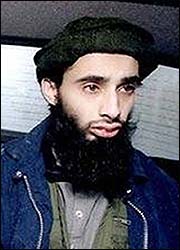Haroon Rashid Aswat
| "“terrorist”" | |
|---|---|
 | |
Haroon Rashid Aswat' (born ca. 1979) is a British citizen of Indian origin [1] whom The UK Times has alleged has ties to Al Qaeda.[2]
Contents
- 1 Suggested role in the London bombings of 7 July 2005
- 2 Possible role in setting up a training camp in Oregon in 1999
- 3 Believed KIA in Afghanistan in 2003
- 4 Resurfaces in South Africa in 2005
- 5 Evades capture
- 6 Capture, and extradition to the United Kingdom
- 7 U.S. extradition proceedings
- 8 References
Suggested role in the London bombings of 7 July 2005
In the two weeks following the 7 July 2005 bombings police sources told newspapers that Aswat made some 20 mobile phone calls to two of the suspected bombers, Mohammed Sidique Khan and Shehzad Tanweer, one just hours before the blasts.[3]
On 31 July 31 2005, following "a more thorough forensic analysis of the remains of the bombers' phones", The Times reported that:
"British investigators, examining whether telephone calls were made between the London bombers and Aswat before the attacks of 7/7, caution that the calls may have been made to a phone linked to Aswat, rather than the man himself."
Possible role in setting up a training camp in Oregon in 1999
Aswat is reported to have first come to the attention of American counter-terrorism officials in 2002, because they believed he helped set up a terrorist training camp in Oregon in the United States in 1999.[4]
According to The Sunday Herald, by 1999, Aswat was calling himself a "hit man" for Osama bin Laden.
Believed KIA in Afghanistan in 2003
Aswat's passport was found on a man killed in action in Afghanistan in early 2003. [5] American and British counterterrorism officials believed the dead man was Aswat.
Resurfaces in South Africa in 2005
Local South African newspapers who interviewed his neighbors and co-workers reported that Aswat had been living an outwardly quiet life in South Africa for at least five months.[6]
Evades capture
The New York Times quotes unnamed security officials that when Aswat's presence was brought to the attention of American authorities they wanted to subject him to an extraordinary rendition. The New York Times sources said British officials objected. "The discussion was whether or not they would render him.
"He's got U.K. papers, and they said you can't render somebody with U.K. papers." Aswat subsequently evaded surveillance in South Africa, and slipped back in to Britain, though the channel port of Felixstowe, in late June 2005.[7] Aswat left Britain, through London's Heathrow airport on July 7, 2005, hours before the bombers struck on that day. On July 29, 2005, during an interview on Fox News a former US prosecutor named John Loftus, asserted that Aswat was a double agent, backed by Britain's MI6.[8] Loftus claimed that MI6 intervened to protect Aswat while he was trying to evade capture.
Capture, and extradition to the United Kingdom
Aswat was reported to have been captured in Pakistan, shortly after the bombings.[9] Aswat was, however, arrested in Zambia, on July 20, 2005.[10] He was deported from Zambia to the UK on 7 August 2005 and arrested on his arrival.
Following Aswat's capture his family issued a press release that stated[11]:
"He has not lived at this house and we have not had contact with him for many years
"There is no story that we can provide."
U.S. extradition proceedings
Once Aswat was transferred to the United Kingdom, he was held in detention on a U.S. arrest warrant.[12][13][14] American justice officials sought to try Aswat for his alleged role in setting up the Oregon training camp in 1999.
A British judge approved Aswat's extradition on 30 November 2006, discounting the concern Aswat's lawyers expressed that there was "a real risk" Aswat would face inhumane treatment in U.S. custody.[15][16] But in 2008 he was transferred to Broadmoor Hospital, a high-security psychiatric hospital after being diagnosed with paranoid schizophrenia.[17]
In 2010 the European Court of Human Rights blocked the extradition orders of Aswat, Abu Hamza, Babar Ahmad and Syed Talha Ahsan.[18][19]
On 16 April 2013, the European Court of Human Rights decided that Aswat's extradition to the U. S. would violate his right for protection against inhumane treatment, given his mental state.[20] The UK Government appealed to for the case to be reconsidered by the court's Grand Chamber, but on 11 September 2013 that was rejected, making the decision became final that Aswat cannot now be extradited.[17]
References
- ↑ Complete 911 Timeline: Haroon Rashid Aswat.
- ↑ The Times - Tangled web that still leaves worrying loose ends - 31 July 2005
- ↑ The Times - Top al-Qaeda Briton called Tube bombers before attack - 21July 2005
- ↑ Brains behind terror plot may be Brit the security services thought - Sunday Herald 31 July 31
- ↑ [http://www.iht.com/articles/2005/07/29/news/britain.php International Herald Tribune - Suspect in London fatal blasts eluded arrest - 30 July 2005
- ↑ UK blast mastermind sold CDs in Johannesburg - 2 August 2005
- ↑ The Sun - Mr Big' seized - 28 July 2005
- ↑ The Guardia - Britain now faces its own blowback: Intelligence interests may thwart the July bombings investigation - Michael Meacher - 10 September 2005
- ↑ Daily Mail - British Al Qaeda suspect 'called bombers' - 21 July 2005
- ↑ Daily Mail - Bombings mastermind held in Zambia - 29 July 2005
- ↑ Fox News - U.K. Gov't Plans Tough Terror Laws - 21 July 2005
- ↑
{{URL|example.com|optional display text}}mirror - ↑
{{URL|example.com|optional display text}}mirror - ↑
{{URL|example.com|optional display text}}mirror - ↑
{{URL|example.com|optional display text}} - ↑
{{URL|example.com|optional display text}}mirror - ↑ a b "Haroon Aswat extradition block upheld by European Court". BBC News. 11 September 2013. Retrieved 11 September 2013.Page Module:Citation/CS1/styles.css must have content model "Sanitized CSS" for TemplateStyles (current model is "Scribunto").
- ↑
{{URL|example.com|optional display text}}mirror - ↑
{{URL|example.com|optional display text}}mirror - ↑ http://hudoc.echr.coe.int/sites/eng/pages/search.aspx?i=001-118583